Punched Card
A punched card, punch card, IBM card, or Hollerith card is a piece of stiff paper that contained either commands for controlling automated machinery or data for data processing applications. Both commands and data were represented by the presence or absence of holes in predefined positions.
Now obsolete as a recording medium, paper tapes constructed from punched cards were widely used throughout the 19th century for controlling textile looms and in the late 19th and early 20th century for controlling fairground organs and related instruments. Punched cards were used through most of the 20th century in what became known as the data processing industry; the use of unit record machines, organized into data processing systems, for data input, processing, and storage.[1] Many early digital computers used punched cards, often prepared using keypunch machines, as the primary medium for input of both computer programs and data.
As of 2015:
- Some voting machines still use punched cards to record data.[2]
- Punched cards for time clocks and other applications are available from the California Tab Card Company.[3]
Paper tape made from punched cards, for a large dance organ
History
A paper tape, constructed from punched cards, in use in a Jacquard loom. The large holes on each edge are sprocket holes, used to pull the paper tape through the loom.
Semen Korsakov's punched card
Charles Babbage proposed the use of "Number Cards", "pierced with certain holes and stand opposite levers connected with a set of figure wheels ... advanced they push in those levers opposite to which there are no holes on the card and thus transfer that number" in his description of the Calculating Engine's Store.[6]
Herman Hollerith invented the recording of data on a medium that could then be read by a machine. Prior uses of machine readable media, such as those above (other than Korsakov), had been for control, not data. "After some initial trials with paper tape, he settled on punched cards...",[7] developing punched card data processing technology for the 1890 US census.
Hollerith founded The Tabulating Machine Company (1896) which was one of four companies that were consolidated to form Computing-Tabulating-Recording Company (CTR), later renamed the International Business Machines Corporation (IBM). IBM manufactured and marketed a variety of unit record machines for creating, sorting, and tabulating punched cards, even after expanding into electronic computers in the late 1950s. IBM developed punched card technology into a powerful tool for business data-processing and produced an extensive line of general purpose unit record machines. By 1950, the IBM card and IBM unit record machines had become ubiquitous in industry and government. "Do not fold, spindle or mutilate," a generalized version of the warning that appeared on some punched cards (generally on those distributed as paper documents to be later returned for further machine processing, checks for example), became a motto for the post-World War II era. [8]
From the 1900s, into the 1950s, punched cards were the primary medium for data entry, data storage, and processing in institutional computing. According to the IBM Archives: "By 1937... IBM had 32 presses at work in Endicott, N.Y., printing, cutting and stacking five to 10 million punched cards every day."[9] Punched cards were even used as legal documents, such as U.S. Government checks[10] and savings bonds. The UNITYPER introduced magnetic tape for data entry in the 1950s. During the 1960s, the punched card was gradually replaced as the primary means for data storage by magnetic tape, as better, more capable computers became available. Mohawk Data Sciences introduced a magnetic tape encoder in 1965, a system marketed as a keypunch replacement which was somewhat successful, but punched cards were still commonly used for data entry and programming until the mid-1980s when the combination of lower cost magnetic disk storage, and affordable interactive terminals on less expensive minicomputers made punched cards obsolete for this role as well.[11] However, their influence lives on through many standard conventions and file formats. The terminals that replaced the punched cards, the IBM 3270 for example, displayed 80 columns of text in text mode, for compatibility with existing software. Some programs still operate on the convention of 80 text columns, although fewer and fewer do as newer systems employ graphical user interfaces with variable-width type fonts.
Today punched cards are mostly obsolete and replaced with other storage methods, except for a few legacy systems and specialized applications.
Nomenclature
The terms punched card, punch card, and punchcard were all commonly used, as were IBM card and Hollerith card (after Herman Hollerith). IBM used "IBM card"[12] or, later, "punched card" at first mention in its documentation and thereafter simply "card" or "cards".[13] Specific formats were often indicated by the number of character positions available, e.g. 80-column card. A sequence of cards that is input to or output from some step in an application's processing is called a card deck or simply deck. The rectangular, round, or oval bits of paper punched out were called chad (chads) or chips (in IBM usage). Adjacent card columns allocated for a specific use, such as names, addresses, multi-digit numbers, etc., are known as a field.Card formats
The Hollerith punched cards used for the US 1890 census were blank.[14] Following that, cards commonly had printing such that the row and column position of a hole could be easily seen. Printing could include having fields named and marked by vertical lines, logos, and more.[15] "General purpose" layouts (see, for example, the IBM 5081 below) were also available. Some cards had one upper corner cut so that cards not oriented correctly, or cards with different corner cuts, could be identified.Hollerith's punched card formats
Hollerith card as shown in the Railroad Gazette in 1895.[16]
- "I was traveling in the West and I had a ticket with what I think was called a punch photograph...the conductor...punched out a description of the individual, as light hair, dark eyes, large nose, etc. So you see, I only made a punch photograph of each person."[18]
Hollerith envisioned a number of card sizes. In an article he wrote describing his proposed system for tabulating the 1890 U.S. Census, Hollerith suggested a card 3 inches by 5½ inches of Manila stock "would be sufficient to answer all ordinary purposes."[20] The cards used in the 1890 census had round holes, 12 rows and 24 columns. A reading board for these cards can be seen at the Columbia University Computing History site.[21] At some point, 3 1⁄4 by 7 3⁄8 inches (82.550 by 187.325 mm) became the standard card size.
Hollerith's original system used an ad-hoc coding system for each application, with groups of holes assigned specific meanings, e.g. sex or marital status. His tabulating machine had up to 40 counters, each with a dial divided into 100 divisions, with two indicator hands; one which stepped one unit with each counting pulse, the other which advanced one unit every time the other dial made a complete revolution. This arrangement allowed a count up to 10,000. During a given tabulating run, each counter was typically assigned a specific hole. Hollerith also used relay logic to allow counts of combination of holes, e.g. to count married females.[20]
Later designs standardized the coding. These cards had ten rows, each row assigned a digit value, 0 through 9, and 45 columns. [22] This provided for a field (adjacent columns) to represent multi-digit numbers that tabulators could sum, instead of their simply counting cards. Hollerith's 45 column punched cards are illustrated in Comrie's The application of the Hollerith Tabulating Machine to Brown's Tables of the Moon.[23][24]
IBM 80-column punched card formats and character codes
A general-purpose punched card from late-twentieth century.
Card from a Fortran program: Z(1) = Y + W(1)
The lower ten positions represented (from top to bottom) the digits 0 through 9. The top two positions of a column were called zone punches, 12 (top) and 11. Originally only numeric information was punched, with 1 punch per column indicating the digit. Signs could be added to a field by overpunching the least significant digit with a zone punch: 12 for plus and 11 for minus. Zone punches had other uses in processing as well, such as indicating a master record.[29]
______________________________________________
/&-0123456789ABCDEFGHIJKLMNOPQR/STUVWXYZ
Y / x xxxxxxxxx
X| x xxxxxxxxx
0| x xxxxxxxxx
1| x x x x
2| x x x x
3| x x x x
4| x x x x
5| x x x x
6| x x x x
7| x x x x
8| x x x x
9| x x x x
|________________________________________________
Reference:[30] Note: The X and Y zones were also called the 11 and 12 zones, respectively.In 1931 IBM began introducing multiple punches for upper-case letters and special characters.[31][32] A letter has two punches (zone [12,11,0] + digit [1–9]); most special characters have two or three punches (zone [12,11,0,or none] + digit [2–7] + 8); a few special characters were exceptions (in EBCDIC "&" is 12 only, "-" is 11 only, and "/" is 0 + 1). With these changes, the information represented in a column by a combination of zones [12, 11] and digits [1–9] is dependent on the use of that column. For example, the combination "12-1" is the letter "A" in an alphabetic column, a plus signed digit "1" in a signed numeric column, or an unsigned digit "1" in a column where the "12" have some other use. The introduction of EBCDIC in 1964 allowed columns with as many as six punches (zones [12,11,0,8,9] + digit [1–7]). IBM and other manufacturers used many different 80-column card character encodings.[33][34] A 1969 American National Standard defined the punches for 128 characters and was named the Hollerith Punched Card Code (often referred to simply as Hollerith Card Code), honoring Hollerith.[35]
Binary punched card.
Invalid "lace cards" such as these pose mechanical problems for card readers.
The 80-column card format dominated the industry, becoming known as just IBM cards, even though other companies made cards and equipment to process them.[citation needed]
A 5081 card from a non-IBM manufacturer.
Mark sense cards
HP Educational Basic optical mark-reader card.
- Mark sense (Electrographic) cards, developed by Reynold B. Johnson at IBM, have printed ovals that could be marked with a special electrographic pencil. Cards would typically be punched with some initial information, such as the name and location of an inventory item. Information to be added, such as quantity of the item on hand, would be marked in the ovals. Card punches with an option to detect mark sense cards could then punch the corresponding information into the card.

Aperture cards
- Aperture cards have a cut-out hole on the right side of the punched card. A 35 mm microfilm chip containing a microform image is mounted in the hole. Aperture cards are used for engineering drawings from all engineering disciplines. Information about the drawing, for example the drawing number, is typically punched and printed on the remainder of the card. Aperture cards have some advantages over fully digital systems for archival purposes.[38]
IBM Stub cards or Short cards
The 80-column card could be scored, on either end, creating a stub that could be torn off, leaving a stub card or short card. A common length for stub cards was 51-columns. Stub cards were used in applications requiring tags, labels, or carbon copies.[28]IBM Port-A-Punch
IBM Port-A-Punch
FORTRAN Port-A-Punch card. Compiler directive "SQUEEZE" removed the alternating blank columns from the input. Godfrey Manning.
IBM 96 column punched card
IBM 96-column punched card format
In the early 1970s, IBM introduced a new, smaller, round-hole, 96-column card format along with the IBM System/3 computer. These cards have tiny (1 mm), circular holes, smaller than those in paper tape. Data is stored in six-bit binary-coded decimal code, with three rows of 32 characters each, or 8-bit EBCDIC. In this format, each column of the top tiers are combined with two punch rows from the bottom tier to form an 8-bit byte, and the middle tier is combined with two more punch rows, so that each card contains 64 bytes of 8-bit-per-byte binary coded data.[40]Powers/Remington Rand UNIVAC card formats
A punched Remington Rand card with an IBM card for comparison
IBM punched card manufacturing
IBM's Fred M. Carroll[44] developed a series of rotary type presses that were used to produce the well-known standard tabulating cards, including a 1921 model that operated at 400 cards per minute (cpm). Later, he developed a completely different press capable of operating at speeds in excess of 800 cpm, and it was introduced in 1936.[9][45] Carroll's high-speed press, containing a printing cylinder, revolutionized the manufacture of punched tabulating cards.[46] It is estimated that between 1930 and 1950, the Carroll press accounted for as much as 25 percent of the company's profits[47]
Institutions, such as universities, often had their general purpose
cards printed with a logo. A wide variety of forms and documents were
printed on punched cards, including checks. Such printing did not
interfere with the operation of the machinery.
A punched card printing plate.
IBM initially required that its customers use only IBM manufactured cards with IBM machines, which were leased, not sold. IBM viewed its business as providing a service and that the cards were part of the machine. In 1932, the US government took IBM to court on this issue. IBM fought all the way to the Supreme Court and lost in 1936; the court ruling that IBM could only set card specifications.[49][50] In another case, heard in 1955, IBM signed a consent decree requiring, amongst other things, that IBM would by 1962 have no more than one-half of the punched card manufacturing capacity in the United States. Tom Watson Jr.'s decision to sign this decree, where IBM saw the punched card provisions as the most significant point, completed the transfer of power to him from Thomas Watson, Sr.[47]
Cultural impact
Cartons of punched cards stored in a United States National Archives Records Service facility in 1959. Each carton could hold 2000 cards.
A punch card tape controlling actuation of the valves of a microfluidics device.
- Artist and architect Maya Lin in 2004 designed a public art installation at Ohio University, titled "Input", that looks like a punched card from the air.[51]
- Do Not Fold, Bend, Spindle or Mutilate: Computer Punch Card Art[52] – a mail art exhibit by the Washington Pavilion in Sioux Falls, South Dakota.
- The Red McCombs School of Business at the University of Texas at Austin has artistic representations of punched cards decorating its exterior walls.
- At the University of Wisconsin - Madison, the exterior windows of the Engineering Research Building[53] were modeled after a punched card layout, during its construction in 1966.
- At the University of North Dakota, the exterior of Gamble Hall, College of Business and Public Administration[54] has a punch card spelling out "University of North Dakota." [55]
- In the Simpsons episode "Much Apu About Nothing", Apu showed Bart his Ph.D. thesis, the world's first computer tic-tac-toe game, stored in a box full of punched cards.
- In the Futurama episode "Mother's Day", as several robots are seen shouting 'Hey hey! Hey ho! 100110!' in protest, one of them burns a punch-card in a manner reminiscent of draft-card burning. In another episode, Put Your Head on My Shoulders, Bender offers a dating service. He hands characters punch-cards so they can put in what they want, before throwing them in his chest cabinet and 'calculating' the 'match' for the person. Bender is shown 'folding', 'bending', and 'mutilating' the card, accentuating the fact that he is making up the 'calculations'.
- In the 1964–65 Free Speech Movement, punched cards became a
metaphor... symbol of the "system"—first the registration system and then bureaucratic systems more generally ... a symbol of alienation ... Punched cards were the symbol of information machines, and so they became the symbolic point of attack. Punched cards, used for class registration, were first and foremost a symbol of uniformity. .... A student might feel "he is one of out of 27,500 IBM cards" ... The president of the Undergraduate Association criticized the University as "a machine ... IBM pattern of education."... Robert Blaumer explicated the symbolism: he referred to the "sense of impersonality... symbolized by the IBM technology."... ––Steven Lubar[56]
- A legacy of the 80 column punched card format is that a display of 80 characters per row is a common choice in the design of character-based terminals. As of September 2014, some character interface defaults, such as the command prompt window's width in Microsoft Windows, remain set at 80 columns and some file formats, such as FITS, still use 80-character card images.
Standards
- ANSI INCITS 21-1967 (R2002), Rectangular Holes in Twelve-Row Punched Cards (formerly ANSI X3.21-1967 (R1997)) Specifies the size and location of rectangular holes in twelve-row 3 1⁄4-inch-wide (83 mm) punched cards.
- ANSI X3.11 – 1990 American National Standard Specifications for General Purpose Paper Cards for Information Processing
- ANSI X3.26 – 1980/R1991) Hollerith Punched Card Code
- ISO 1681:1973 Information processing – Unpunched paper cards – Specification
- ISO 6586:1980 Data processing – Implementation of the ISO 7- bit and 8- bit coded character sets on punched cards. Defines ISO 7-bit and 8-bit character sets on punched cards as well as the representation of 7-bit and 8-bit combinations on 12-row punched cards. Derived from, and compatible with, the Hollerith Code, ensuring compatibility with existing punched card files.









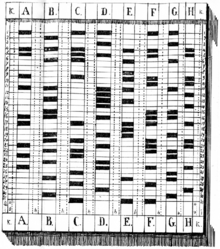
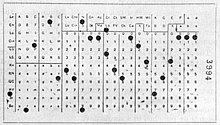

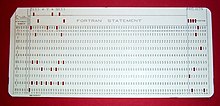

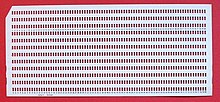




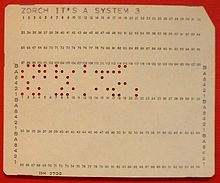






Post A Comment:
0 comments: